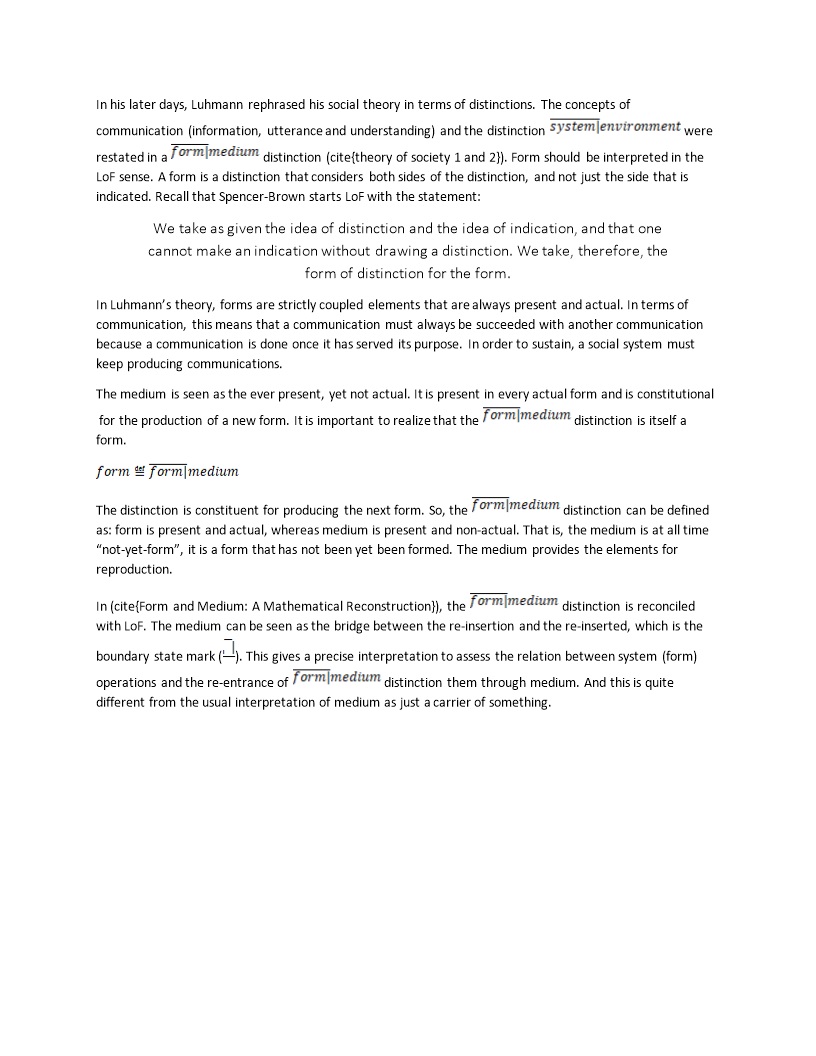|
|
| Regel 1: |
Regel 1: |
| '''!!!''' <u>De schuingedrukte tekst hieronder bevat veel speciale tekens die we zelf moeten gaan toevoegen (zie</u> {{Cite|resource=Bestand:Later Developments symbols.pdf|name=PDF met dezelfde tekst als hieronder|dialog=process-file-dialog}}<u>):</u>
| | [[Bestand:Luhmann 02.jpg|gecentreerd|kaderloos|1056x1056px]] |
| | | <accesscontrol>Access:We got to move</accesscontrol> |
| '''''In his later days, Luhmann rephrased his social theory in terms of distinctions. The concepts of communication (information, utterance and understanding) and the distinction 𝑠𝑦𝑠𝑡𝑒𝑚|̅̅̅̅̅̅̅̅̅̅̅𝑒𝑛𝑣𝑖𝑟𝑜𝑛𝑚𝑒𝑛𝑡 were restated in a 𝑓𝑜𝑟𝑚|̅̅̅̅̅̅̅̅𝑚𝑒𝑑𝑖𝑢𝑚 distinction (cite{theory of society 1 and 2}). Form should be interpreted in the LoF sense. A form is a distinction that considers both sides of the distinction, and not just the side that is indicated. Recall that Spencer-Brown starts LoF with the statement:'''''
| |
| | |
| '''''We take as given the idea of distinction and the idea of indication, and that one cannot make an indication without drawing a distinction. We take, therefore, the form of distinction for the form.'''''
| |
| | |
| '''''In Luhmann’s theory, forms are strictly coupled elements that are always present and actual. In terms of communication, this means that a communication must always be succeeded with another communication because a communication is done once it has served its purpose. In order to sustain, a social system must keep producing communications.'''''
| |
| | |
| '''''The medium is seen as the ever present, yet not actual. It is present in every actual form and is constitutional for the production of a new form. It is important to realize that the 𝑓𝑜𝑟𝑚|̅̅̅̅̅̅̅̅𝑚𝑒𝑑𝑖𝑢𝑚 distinction is itself a form. 𝑓𝑜𝑟𝑚≝𝑓𝑜𝑟𝑚|̅̅̅̅̅̅̅̅𝑚𝑒𝑑𝑖𝑢𝑚'''''
| |
| | |
| '''''The distinction is constituent for producing the next form. So, the 𝑓𝑜𝑟𝑚|̅̅̅̅̅̅̅̅𝑚𝑒𝑑𝑖𝑢𝑚 distinction can be defined as: form is present and actual, whereas medium is present and non-actual. That is, the medium is at all time “not-yet-form”, it is a form that has not been yet been formed. The medium provides the elements for reproduction.'''''
| |
| | |
| '''''In (cite{Form and Medium: A Mathematical Reconstruction}), the 𝑓𝑜𝑟𝑚|̅̅̅̅̅̅̅̅𝑚𝑒𝑑𝑖𝑢𝑚 distinction is reconciled with LoF. The medium can be seen as the bridge between the re-insertion and the re-inserted, which is the boundary state mark (ˌ |̅). This gives a precise interpretation to assess the relation between system (form) operations and the re-entrance of 𝑓𝑜𝑟𝑚|̅̅̅̅̅̅̅̅𝑚𝑒𝑑𝑖𝑢𝑚 distinction them through medium. And this is quite different from the usual interpretation of medium as just a carrier of something.'''''
| |
| | |
| | |
| | |
| | |
| | |
| | |
| | |
| {{LC Book config}} | | {{LC Book config}} |
| {{Light Context | | {{Light Context |
| Regel 37: |
Regel 19: |
| |Preparatory reading=LC 00499 | | |Preparatory reading=LC 00499 |
| |Continue reading=LC 00508, | | |Continue reading=LC 00508, |
| }}<accesscontrol>Access:We got to move</accesscontrol> | | }} |

